
The Cimmerian Sibyl, by name Carmentis, was the prophetic priestess presiding over the Apollonian Oracle at Cimmerium in Italy, near Lake Avernus, Cumae area.

The Cimmerian Sibyl, by name Carmentis, was the prophetic priestess presiding over the Apollonian Oracle at Cimmerium in Italy, near Lake Avernus, Cumae area.
The word Sibyl comes (via Latin) from the ancient Greek word sibylla, meaning prophetess. There were many sibyls in the ancient world (e.g., Samian, Cumaean), but the Cimmerian Sibyl was venerated by the pre-Hellenic native populations.
The Cimmerian Sibyl may have been a doublet for the Cumaean since the designation Cimmerian refers to priestesses who lived underground near Lake Avernus. An oracular shrine dedicated to Apollo, as at Delphi, stood on the Acropolis of Cumae. An underground Roman road ran from the southeastern part of Cumae, through Mount Grillo to the shores of Lake Avernus. However, there are sources that distinguished the two Sibyls, such as those that noted it was the Cumaean and not the Cimmerian Sibyl who offered King Tarquin her book of prophecies. [1]
The Sibyl was mentioned by the Campanian playwright Naevius in his play Carmen belli penici written between 235 and 204 BC. [2] This is one of the earliest references of the Italian Sibyl. [2] Naevius also named the Cimmerian Sibyl in his books of the Punic War and Piso in his annals (Varro in Lactantius Inst. 1.6.9). An account also cited that it was the dramatist who accompanied Aeneas in the late third century B.C. when he visited the Cimmerian Sibyl. [3]
The prophetess was also cited in an encyclopedia called Liber Floridus attributed to Lambert of St. Omer, where the Sibyl was distinguished from the Samian Sibyl. [4] She was identified in this text as "India" while the latter was called "Phemonoe." [4]
The Sibyl's son Evander founded in Rome the first shrine of Pan which is called the Lupercal or Lupercum. [5] [6]

An oracle is a person or thing considered to provide insight, wise counsel or prophetic predictions, most notably including precognition of the future, inspired by deities. If done through occultic means, it is a form of divination.

The Cimmerians were an ancient Eastern Iranic equestrian nomadic people originating in the Pontic–Caspian steppe, part of whom subsequently migrated into West Asia. Although the Cimmerians were culturally Scythian, they formed an ethnic unit separate from the Scythians proper, to whom the Cimmerians were related and who displaced and replaced the Cimmerians.

Dodona in Epirus in northwestern Greece was the oldest Hellenic oracle, possibly dating to the 2nd millennium BCE according to Herodotus. The earliest accounts in Homer describe Dodona as an oracle of Zeus. Situated in a remote region away from the main Greek poleis, it was considered second only to the Oracle of Delphi in prestige.
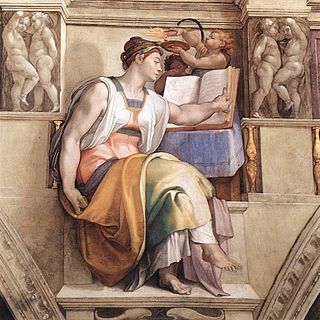
The Erythraean Sibyl was the prophetess of classical antiquity presiding over the Apollonian oracle at Erythrae, a town in Ionia opposite Chios, which was built by Neleus, the son of Codrus.

Avernus was an ancient name for a volcanic crater near Cumae (Cuma), Italy, in the region of Campania west of Naples. Part of the Phlegraean Fields of volcanoes, Avernus is approximately 3.2 kilometres (2.0 mi) in circumference. Within the crater is Lake Avernus.
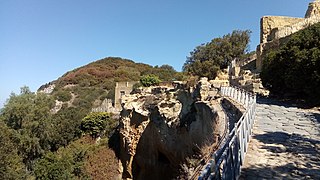
Cumae was the first ancient Greek colony of Magna Graecia on the mainland of Italy and was founded by settlers from Euboea in the 8th century BCE. It became a rich Roman city, the remains of which lie near the modern village of Cuma, a frazione of the comune Bacoli and Pozzuoli in the Metropolitan City of Naples, Campania, Italy. The archaeological museum of the Campi Flegrei in the Aragonese castle contains many finds from Cumae.
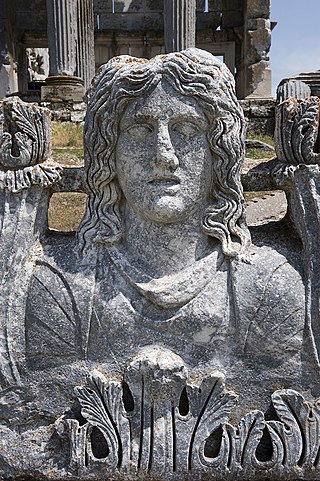
The sibyls were prophetesses or oracles in Ancient Greece.

The Battle of Cumae is the name given to at least two battles between Cumae and the Etruscans:

The Sibylline Oracles are a collection of oracular utterances written in Greek hexameters ascribed to the Sibyls, prophetesses who uttered divine revelations in a frenzied state. Fourteen books and eight fragments of Sibylline Oracles survive, in an edition of the 6th or 7th century AD. They are not to be confused with the original Sibylline Books of the ancient Etruscans and Romans which were burned by order of the Roman general Flavius Stilicho in the 4th century AD. Instead, the text is an "odd pastiche" of Hellenistic and Roman mythology interspersed with Jewish, Gnostic and early Christian legend.
The Sibylline Books were a collection of oracular utterances, set out in Greek hexameter verses, that, according to tradition, were purchased from a sibyl by the last king of Rome, Lucius Tarquinius Superbus, and consulted at momentous crises through the history of the Roman Republic and the Empire.

The Grotta di Cocceio is an ancient Roman tunnel nearly a kilometre in length connecting Lake Avernus with Cumae and dating from 38-36 BC. It was burrowed through the tuff stone of Monte Grillo by the architect Lucius Cocceius Auctus at the command of Agrippa who was in the process of converting the Lake into a military port, the Portus Julius.

The Crypta Neapolitana is an ancient Roman road tunnel near Naples, Italy. It was built in 37 BC and is over 700 metres long.

The Delphic Sibyl was a woman who was a prophet associated with early religious practices in Ancient Greece and is said to have been venerated from before the Trojan Wars as an important oracle. At that time Delphi was a place of worship for Gaia, the mother goddess connected with fertility rituals that are thought to have existed throughout the ancient Mediterranean world. As needed to maintain the religious tradition, the role of sibyl would pass to another priestess at each site.
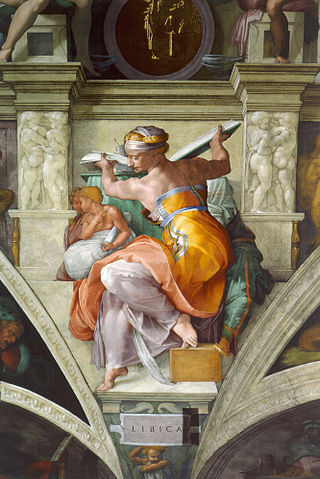
The Libyan Sibyl was the prophetic priestess presiding over the Oracle of Zeus-Ammon at Siwa Oasis in the Libyan Desert.
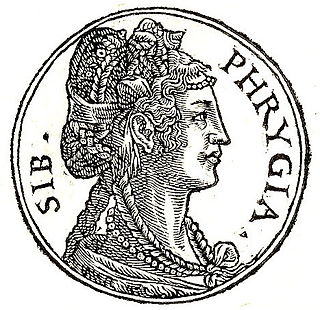
In the extended complement of sibyls of the Gothic and Renaissance imagination, the Phrygian Sibyl was the priestess presiding over an Apollonian oracle at Phrygia, a historical kingdom in the west central part of the Anatolian highlands. She was popularly identified with Cassandra, prophetess daughter of Priam's in Homer's Iliad.

The Cumaean Sibyl was the priestess presiding over the Apollonian oracle at Cumae, a Greek colony near Naples, Italy. The word sibyl comes from the ancient Greek word sibylla, meaning prophetess. There were many sibyls throughout the ancient world. Because of the importance of the Cumaean Sibyl in the legends of early Rome as codified in Virgil's Aeneid VI, and because of her proximity to Rome, the Cumaean Sibyl became the most famous among the Romans. The Erythraean Sibyl from modern-day Turkey was famed among Greeks, as was the oldest Hellenic oracle, the Sibyl of Dodona, dating to the second millennium BC according to Herodotus, favored in the east.
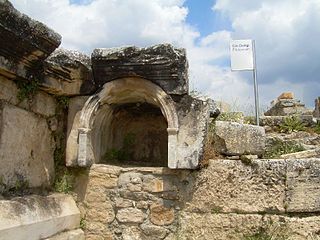
A ploutonion is a sanctuary specially dedicated to the ancient Greek god Plouton. Only a few such shrines are known from classical sources, usually at locations that produce poisonous emissions and were considered to represent an entrance to the underworld.

Eclogue 4, also known as the Fourth Eclogue, is the name of a Latin poem by the Roman poet Virgil. Part of his first major work, the Eclogues, the piece was written around 40 BC, during a time of brief stability following the Treaty of Brundisium; it was later published in and around the years 39–38 BC. The work describes the birth of a boy, a supposed savior, who once of age will become divine and eventually rule over the world. During late antiquity and the Middle Ages, a desire emerged to view Virgil as a virtuous pagan, and as such the early Christian theologian Lactantius, and St. Augustine—to varying degrees—reinterpreted the poem to be about the birth of Jesus Christ.

The Golden Bough is a painting from 1834 by the English painter J. M. W. Turner. It depicts the episode of the golden bough from the Aeneid by Virgil. It is in the collection of the Tate galleries.
The oracle of Nusku was a slave-girl from the outskirts of Harran who lived at the time of the late Neo-Assyrian Empire and was heavily involved in the Sasî movement, which aimed to depose the king Esarhaddon. In 671 BC she claimed to receive a divine message from the god Nusku that the Assyrian official Sasi was to become king and that Esarhaddon and his family were to be destroyed. The oracle placed herself under the protection of Sasi, became a leading figure of a conspiracy to seat him on the throne and continued to speak in support of him. Sasi's rapid gain of supporters, including influential figures in the imperial administration, is probably attributable to the great personal charisma of the oracle.
![]() Media related to Sibyl Cimmeria at Wikimedia Commons
Media related to Sibyl Cimmeria at Wikimedia Commons